American actress Lillian Gish (1893-1993) was 'The First Lady of the Silent Screen'. During the 1910s, she was one of director D.W. Griffith's greatest stars. She appeared in his features such as The Birth of a Nation (1915), Broken Blossoms (1919), and Orphans of the Storm (1921). After 13 years with Griffith, she moved to MGM where her first picture was La Bohème (King Vidor, 1926). In the 1940s, after a long interval, she returned to the screen in a handful of films and received a Best Supporting Actress Oscar nomination for her role as Laura Belle McCanles in Duel in the Sun (King Vidor, 1946). Again a decade later she was marvellous in the classic Film Noir The Night of the Hunter (Charles Laughton, 1955). Her last film was The Whales of August (Lindsay Anderson, 1987) in which she shared the lead with Bette Davis.
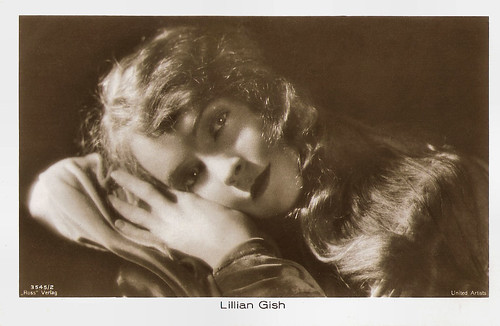
German postcard by Ross Verlag, no. 3545/2, 1928-1929. Photo: United Artists.

French postcard by Cinémagazine-Edition, Paris, no. 236.
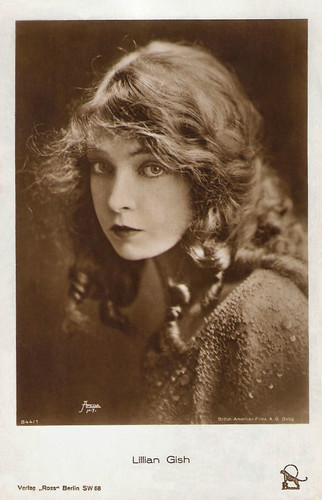
German postcard by Ross-Verlag, no. 844/1, 1925-1926. Photo: Apeda (Alexander W. Dreyfoos), New York / British-American-Films A.G. Bafag.
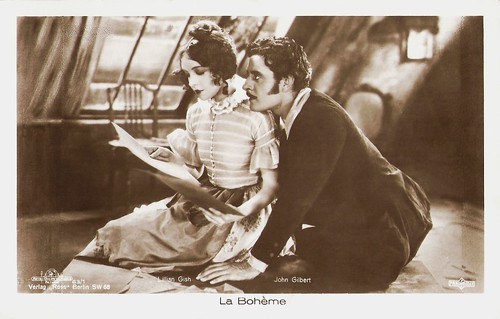
German postcard by Ross Verlag, no. 63/1. Photo: Metro-Goldwyn-Mayer (MGM) / Parufamet. Publicity still for La Bohème (King Vidor, 1926) with John Gilbert.
Lillian Diana Gish was born in 1893 in Springfield, Ohio. Her restless father James Lee Gish was an alcoholic who was rarely at home and left the family to more or less to fend for themselves. Mary Robinson McConnell a.k.a. Mary Gish, her mother, had entered into acting in local productions to make money to support the family. As soon as Lillian and her sister Dorothy were old enough, they joined her.
Lillian was six years old when she first appeared in front of an audience. For the next 13 years, she and Dorothy appeared in melodramas before stage audiences with great success. To supplement their income, the two sisters also posed for pictures and paintings. In 1912, their former neighbour girl and child actress Mary Pickford introduced the sisters to film director David Wark Griffith and helped get them contracts with Biograph Studios.
Griffith cast them in the short silent films An Unseen Enemy (D.W. Griffith, 1912), followed by The One She Loved (D.W. Griffith, 1912) and My Baby (D.W. Griffith, 1912). Griffith saw Lillian as an exquisitely fragile, ethereal beauty, and in 1912, she would make 12 films for him.
With 25 films in the next two years, Lillian's exposure to the public was so great that she fast became one of the top stars in the industry, right alongside Mary Pickford. With her doll-like looks and small frame she portrayed innocent, virginal characters who are victimised by a cruel world.
In 1915, Lillian starred as Elsie Stoneman in D.W. Griffith's most ambitious project to date, The Birth of a Nation (D.W. Griffith, 1915). It was the highest-grossing film of the silent era. The following year, she appeared in another Griffith classic, Intolerance: Love's Struggle Throughout the Ages (D.W. Griffith, 1916). Other famous Griffith productions in which Gish starred were Broken Blossoms or The Yellow Man and the Girl (D.W. Griffith, 1919), Way Down East (D.W. Griffith, 1920), and Orphans of the Storm (D.W. Griffith, 1921), opposite her sister Dorothy.
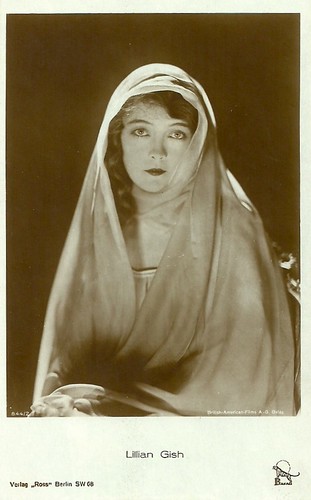
German postcard by Ross Verlag, no. 844/2. Photo: British-American Film A.-G. (Bafag), Berlin. Lillian Gish in the film The White Sister (Henry King 1923), shot in Italy.
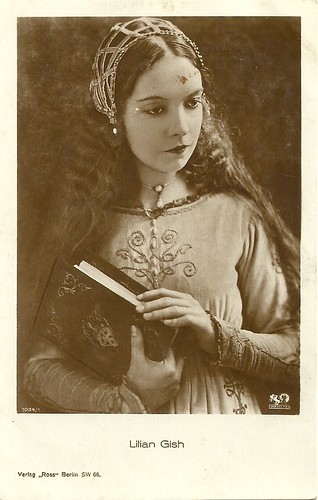
German postcard by Ross Verlag, no. 1034/1, 1927-1928. Photo: Phoebus Film. Lillian Gish in the American period piece Romola (Henry King, 1924), shot on location in Italy, and set in Renaissance Florence.
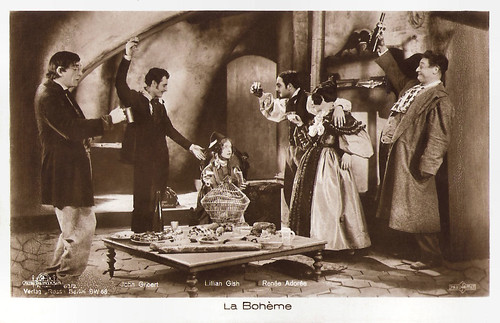
German postcard by Ross Verlag, no. 63/2. Photo: Metro-Goldwyn-Mayer (MGM) / Parufamet. Publicity still for La Bohème (King Vidor, 1926) with John Gilbert and Renée Adorée.
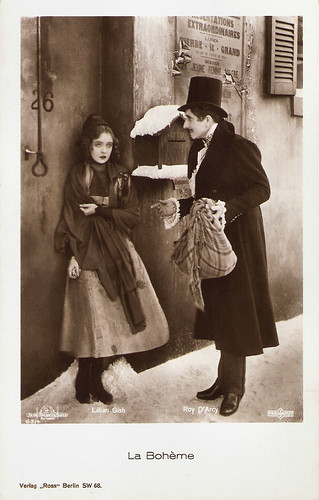
German postcard by Ross Verlag, no. 63/4. Photo: Metro-Goldwyn-Mayer (MGM) / Parufamet. Publicity still for La Bohème (King Vidor, 1926) with Roy D'Arcy.
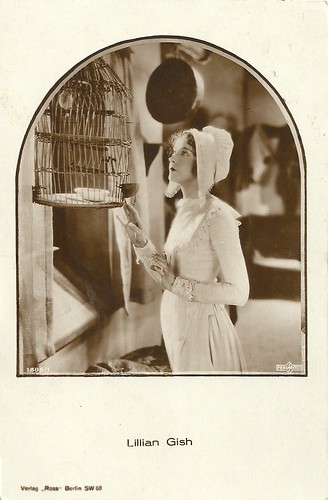
German postcard by Ross Verlag, no. 1885/1, 1927-1928. Photo: Parufamet. Lillian Gish in The Scarlet Letter (Victor Sjöström, 1926).
By the early 1920s, Lillian Gish was known as 'The First Lady of the American cinema', according to Wikipedia. Lillian even tried her hand at film directing with Remodeling Her Husband (Lillian Gish, 1920), when D. W. Griffith took his unit on location. The film, starring her sister Dorothy Gish, is now considered lost.
Then, she could make two films entirely in Italy. In the excellent The White Sister (Henry King, 1923), she played a young woman who becomes a nun when she believes her sweetheart (Ronald Colman) has been killed, but things get complicated when he returns alive. Henry King directed her and Colman also in the costume drama Romola (Henry King, 1924), in which also her sister Dorothy co-starred.
D.W. Griffith’s career seemed on its way down. After 13 years with him, Lillian moved to MGM. Her new contract gave her control over the type of picture, the director, the supporting lead and the cameraman.
1926 became her busiest year of the decade with roles in La Bohème (King Vidor, 1926) with John Gilbert, and The Scarlet Letter (Victor Sjöström, 1926). Gish's favourite film of her MGM career, The Wind (Victor Sjöström, 1928), was a commercial failure, but is now recognised as one of the most distinguished works of the silent period.
As the decade wound to a close, ‘talkies’ were replacing silent films, and Gish began to appear for the radio and in acclaimed stage productions. In 1933, she appeared in one sound film, His Double Life (Arthur Hopkins, 1933) with Roland Young, and then didn't make another film for ten years. She appeared in stage roles as varied as Ophelia in Guthrie McClintic's 1936 production of Hamlet, with John Gielgud, and Marguerite in a limited run of La Dame aux Camélias.
Tony Fontana at IMDb: “Lillian never forgot D.W. Griffith, even when everyone else in Hollywood did. She helped care for the ailing Griffith and his wife until Griffith died in 1948.”
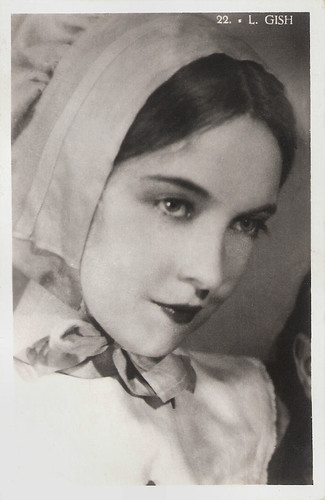
Italian postcard, no. 22. Publicity still for The Scarlet Letter (Victor Sjöström, 1926).
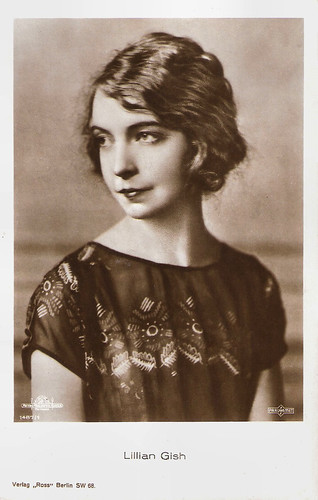
German postcard by Ross-Verlag, no. 1487/1, , 1927-1928. Photo: Metro-Goldwyn Mayer / FaNaMet.
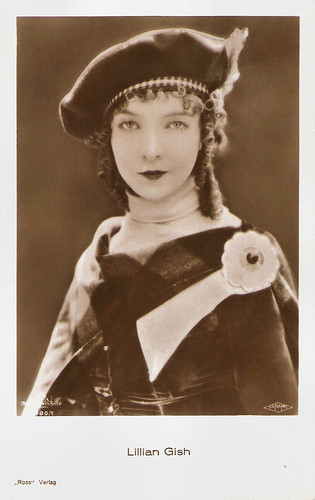
German postcard by Ross-Verlag, no. 1980/1, 1927-1928. Photo: Metro-Goldwyn Mayer / FaNaMet. Publicity still for Annie Laurie (John S. Robertson, 1927).
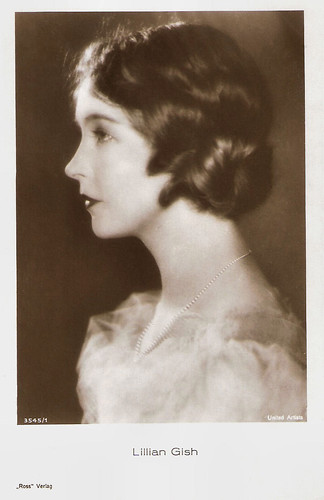
German postcard by Ross-Verlag, no. 3545/1, 1928-1929. Photo: United Artists.

Spanish postcard by EFB, no. A-62.
When Lillian Gish returned to the screen in 1943, she played in two big-budget Hollywood pictures, the war drama Commandos Strike at Dawn (John Farrow, 1942) and Top Man (Charles Lamont, 1943). Denny Jackson at IMDb: “Although these roles did not bring her the attention she had in her early career, Lillian still proved she could hold her own with the best of them.”
She earned an Oscar nomination as Best Supporting Actress for her role of Laura Belle McCanles in the Western Duel in the Sun (King Vidor, 1946). She now excelled playing wilful but conflicted women.
One of the most critically acclaimed roles of her career came in the Film Noir The Night of the Hunter (Charles Laughton, 1955). She played a rural guardian angel protecting her charges from a murderous preacher played by Robert Mitchum. In 1969, she published her autobiography The Movies, Mr. Griffith, and Me. A year later, she received a special Academy Award 'for superlative artistry and distinguished contributions to the progress of motion pictures'.
In her later years Gish became a dedicated advocate for the appreciation and preservation of silent film. At the age of 93, she made what was to be her last film, The Whales of August (Lindsay Anderson, 1987), in which Bette Davis and she starred as elderly sisters in Maine. It exposed her to a new generation of fans.
In 1993, Lillian Gish died at age 99 peacefully in her sleep in New York City. Her 75-year film career is almost unbeatable. Gish never married or had children. She left her entire estate, which was valued at several million dollars, to actress Helen Hayes, who died 18 days after Gish.
Trailer Duel in the Sun (1946). Source: Movieclips Trailer Vault (YouTube).
Trailer The Night of the Hunter (1955). Source: Criterion Collection (YouTube).
Trailer The Whales of August (1987). Source: mimzy84 (YouTube).
Sources: Tony Fontana (IMDb), Denny Jackson (IMDb), Wikipedia and IMDb.

German postcard by Ross Verlag, no. 3545/2, 1928-1929. Photo: United Artists.

French postcard by Cinémagazine-Edition, Paris, no. 236.

German postcard by Ross-Verlag, no. 844/1, 1925-1926. Photo: Apeda (Alexander W. Dreyfoos), New York / British-American-Films A.G. Bafag.

German postcard by Ross Verlag, no. 63/1. Photo: Metro-Goldwyn-Mayer (MGM) / Parufamet. Publicity still for La Bohème (King Vidor, 1926) with John Gilbert.
An exquisitely fragile, ethereal beauty
Lillian Diana Gish was born in 1893 in Springfield, Ohio. Her restless father James Lee Gish was an alcoholic who was rarely at home and left the family to more or less to fend for themselves. Mary Robinson McConnell a.k.a. Mary Gish, her mother, had entered into acting in local productions to make money to support the family. As soon as Lillian and her sister Dorothy were old enough, they joined her.
Lillian was six years old when she first appeared in front of an audience. For the next 13 years, she and Dorothy appeared in melodramas before stage audiences with great success. To supplement their income, the two sisters also posed for pictures and paintings. In 1912, their former neighbour girl and child actress Mary Pickford introduced the sisters to film director David Wark Griffith and helped get them contracts with Biograph Studios.
Griffith cast them in the short silent films An Unseen Enemy (D.W. Griffith, 1912), followed by The One She Loved (D.W. Griffith, 1912) and My Baby (D.W. Griffith, 1912). Griffith saw Lillian as an exquisitely fragile, ethereal beauty, and in 1912, she would make 12 films for him.
With 25 films in the next two years, Lillian's exposure to the public was so great that she fast became one of the top stars in the industry, right alongside Mary Pickford. With her doll-like looks and small frame she portrayed innocent, virginal characters who are victimised by a cruel world.
In 1915, Lillian starred as Elsie Stoneman in D.W. Griffith's most ambitious project to date, The Birth of a Nation (D.W. Griffith, 1915). It was the highest-grossing film of the silent era. The following year, she appeared in another Griffith classic, Intolerance: Love's Struggle Throughout the Ages (D.W. Griffith, 1916). Other famous Griffith productions in which Gish starred were Broken Blossoms or The Yellow Man and the Girl (D.W. Griffith, 1919), Way Down East (D.W. Griffith, 1920), and Orphans of the Storm (D.W. Griffith, 1921), opposite her sister Dorothy.

German postcard by Ross Verlag, no. 844/2. Photo: British-American Film A.-G. (Bafag), Berlin. Lillian Gish in the film The White Sister (Henry King 1923), shot in Italy.

German postcard by Ross Verlag, no. 1034/1, 1927-1928. Photo: Phoebus Film. Lillian Gish in the American period piece Romola (Henry King, 1924), shot on location in Italy, and set in Renaissance Florence.

German postcard by Ross Verlag, no. 63/2. Photo: Metro-Goldwyn-Mayer (MGM) / Parufamet. Publicity still for La Bohème (King Vidor, 1926) with John Gilbert and Renée Adorée.

German postcard by Ross Verlag, no. 63/4. Photo: Metro-Goldwyn-Mayer (MGM) / Parufamet. Publicity still for La Bohème (King Vidor, 1926) with Roy D'Arcy.

German postcard by Ross Verlag, no. 1885/1, 1927-1928. Photo: Parufamet. Lillian Gish in The Scarlet Letter (Victor Sjöström, 1926).
The First Lady of the American cinema
By the early 1920s, Lillian Gish was known as 'The First Lady of the American cinema', according to Wikipedia. Lillian even tried her hand at film directing with Remodeling Her Husband (Lillian Gish, 1920), when D. W. Griffith took his unit on location. The film, starring her sister Dorothy Gish, is now considered lost.
Then, she could make two films entirely in Italy. In the excellent The White Sister (Henry King, 1923), she played a young woman who becomes a nun when she believes her sweetheart (Ronald Colman) has been killed, but things get complicated when he returns alive. Henry King directed her and Colman also in the costume drama Romola (Henry King, 1924), in which also her sister Dorothy co-starred.
D.W. Griffith’s career seemed on its way down. After 13 years with him, Lillian moved to MGM. Her new contract gave her control over the type of picture, the director, the supporting lead and the cameraman.
1926 became her busiest year of the decade with roles in La Bohème (King Vidor, 1926) with John Gilbert, and The Scarlet Letter (Victor Sjöström, 1926). Gish's favourite film of her MGM career, The Wind (Victor Sjöström, 1928), was a commercial failure, but is now recognised as one of the most distinguished works of the silent period.
As the decade wound to a close, ‘talkies’ were replacing silent films, and Gish began to appear for the radio and in acclaimed stage productions. In 1933, she appeared in one sound film, His Double Life (Arthur Hopkins, 1933) with Roland Young, and then didn't make another film for ten years. She appeared in stage roles as varied as Ophelia in Guthrie McClintic's 1936 production of Hamlet, with John Gielgud, and Marguerite in a limited run of La Dame aux Camélias.
Tony Fontana at IMDb: “Lillian never forgot D.W. Griffith, even when everyone else in Hollywood did. She helped care for the ailing Griffith and his wife until Griffith died in 1948.”

Italian postcard, no. 22. Publicity still for The Scarlet Letter (Victor Sjöström, 1926).

German postcard by Ross-Verlag, no. 1487/1, , 1927-1928. Photo: Metro-Goldwyn Mayer / FaNaMet.

German postcard by Ross-Verlag, no. 1980/1, 1927-1928. Photo: Metro-Goldwyn Mayer / FaNaMet. Publicity still for Annie Laurie (John S. Robertson, 1927).

German postcard by Ross-Verlag, no. 3545/1, 1928-1929. Photo: United Artists.

Spanish postcard by EFB, no. A-62.
A rural guardian angel protecting her charges from a murderous preacher
When Lillian Gish returned to the screen in 1943, she played in two big-budget Hollywood pictures, the war drama Commandos Strike at Dawn (John Farrow, 1942) and Top Man (Charles Lamont, 1943). Denny Jackson at IMDb: “Although these roles did not bring her the attention she had in her early career, Lillian still proved she could hold her own with the best of them.”
She earned an Oscar nomination as Best Supporting Actress for her role of Laura Belle McCanles in the Western Duel in the Sun (King Vidor, 1946). She now excelled playing wilful but conflicted women.
One of the most critically acclaimed roles of her career came in the Film Noir The Night of the Hunter (Charles Laughton, 1955). She played a rural guardian angel protecting her charges from a murderous preacher played by Robert Mitchum. In 1969, she published her autobiography The Movies, Mr. Griffith, and Me. A year later, she received a special Academy Award 'for superlative artistry and distinguished contributions to the progress of motion pictures'.
In her later years Gish became a dedicated advocate for the appreciation and preservation of silent film. At the age of 93, she made what was to be her last film, The Whales of August (Lindsay Anderson, 1987), in which Bette Davis and she starred as elderly sisters in Maine. It exposed her to a new generation of fans.
In 1993, Lillian Gish died at age 99 peacefully in her sleep in New York City. Her 75-year film career is almost unbeatable. Gish never married or had children. She left her entire estate, which was valued at several million dollars, to actress Helen Hayes, who died 18 days after Gish.
Trailer Duel in the Sun (1946). Source: Movieclips Trailer Vault (YouTube).
Trailer The Night of the Hunter (1955). Source: Criterion Collection (YouTube).
Trailer The Whales of August (1987). Source: mimzy84 (YouTube).
Sources: Tony Fontana (IMDb), Denny Jackson (IMDb), Wikipedia and IMDb.
No comments:
Post a Comment